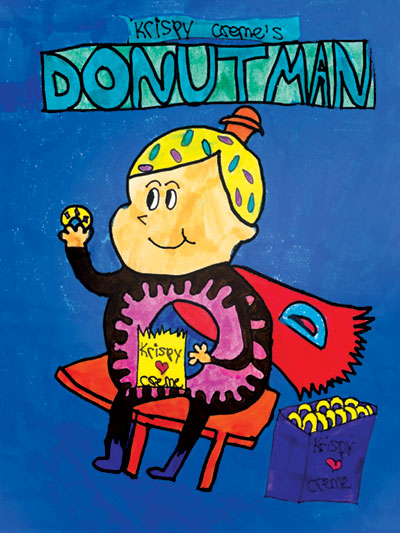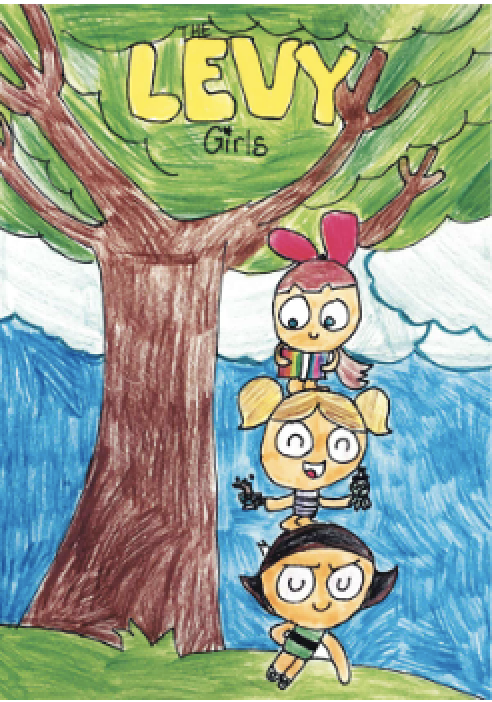 |
 |
| Yocheved Levy, comic book cover. |
Chaya Kohanbash, Secret Cat. |
 |
 |
| Aiden Pollak, Donut Man. |
Eliyah Levy, The Levy Girls |
Early in my career, I harnessed that passion for cartoons by making it part of my curriculum. I collected binders full of characters for my students to copy directly or incorporate into their work. After a couple of years though, I got tired of seeing copy after copy of other artists’ work. My students’ skills were clearly growing, but what about their creativity, their other interests, their own unique points of view? There had to be a better way to use those cartoon studies towards the development of more personal student work.
Artist Jack Kirby
In 2017, the world celebrated the 100th birthday of Jack Kirby, the artist who co-created some of the most famous comic book characters in the world. In honor of his centennial, DC and Marvel hired contemporary comic book artists to draw their own versions of classic Kirby comics. That project sparked an idea.
I challenged students to pick a favorite comic book and adapt its cover to create their own original work of art. Kirby’s birthday was an inspiration. Jean-Michel Basquiat, Mark Todd’s comic book paintings, and Robert Goodin’s “Covered” blog provided more diverse examples. These pieces of professional art proved to my students that their desire to copy from comic books was legitimate. They also demonstrated that those copies could be the foundation for something more ambitious or personal. How would my students use their comic books to inform their own unique work?
Procedures
I provided my classes with about 200 comic book covers printed from the internet. I provided a visual rubric with examples to show the amount of effort I expected to see. Students began by loosely sketching on tag board the basic shapes of their selected comic book. This step provided a rich opportunity for me to discuss composition and proportion with my classes. At this stage, many students’ drawings looked like loose, pale ghosts of the comic book covers sitting in front of them.
Same Cover, Different Artist
Then the fun began! Students were permitted to copy their comics as exactly as they could. I showed them examples from professional artists who simply recreated Kirby’s comics in their own style. Students were relieved to see that they didn’t have to conceive a grand idea to create an interesting and original work of art. “All the artists draw a different way,” one student noticed. So, even when different artists all drew the same Kirby cover, they all made something new and different. Many students felt liberated by the realization that their copies would actually be better if they weren’t the same as the original.
 |
| Noam Sokol, The Brain |
Something New
Towards that end, I encouraged students to use the “bones” that they had drawn to create something completely new. The compositions of famous comic- book covers were already sketched into place. So, “What if you replace Spider- Man with your own superhero? Instead of drawing Tintin running with Snowy, what if you drew yourself playing soccer?” There was no shortage of examples of celebrated professionals creating their own artwork in this way.
My classes were ignited! The project took twice as long as I expected because so many students were invested in making their comic book covers as excellent as they could be. For me, the project was extremely versatile. In addition to the art skills mentioned above, I used the lesson to teach students about analogous and complementary colors, contrast, dynamic movement, emphasis, foreshortening, inking, and brush techniques.
I displayed the artworks in our school’s art gallery. The reaction was refreshing. Parents and teachers commented on how original students’ drawings were. “Children are so creative, aren’t they? How do they think of things like this?!” What’s that famous art quote? “Good artists copy...”
Rama Hughes is an art teacher at Yavneh Hebrew Academy in Los Angeles, California, and a contributing editor for SchoolArts. Rama@RamaHughes.com
NATIONAL STANDARD
Connecting: Relating artistic ideas and work with personal meaning and external context.
WEB LINK
Marvel Comics Creator Spotlight: Jack Kirby
View this article in the digital edition.






